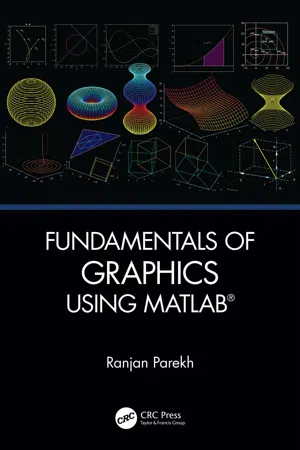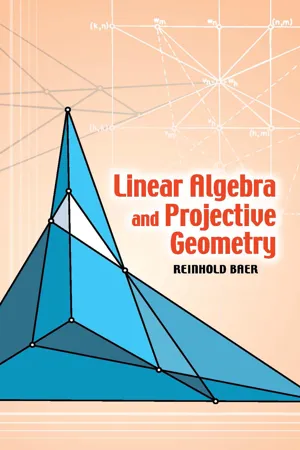Mathematics
Projections
In mathematics, projections refer to the transformation of points or objects onto a lower-dimensional space. This process involves capturing the essential features of the original object while reducing its complexity. Projections are widely used in various mathematical fields, such as linear algebra, geometry, and computer graphics, to simplify and analyze complex structures.
Written by Perlego with AI-assistance
Related key terms
Related key terms
1 of 4
Related key terms
1 of 3
4 Key excerpts on "Projections"
- Hongyu Guo(Author)
- 2014(Publication Date)
- WSPC(Publisher)
3 , Eq. 1.8 takes a simpler formwhere ƒ is a constant, which is the image distance. Note that Eq. 1.7 is not linear, but when the perspective projection is discussed in projective space using homogeneous coordinates, Eq. 1.9 is linear. The perspective projection is reduced to matrix multiplication. This is a big advantage of using homogeneous coordinates in the projective space. In computer graphics, the central projection is computed with a dedicated graphics processor GPU, which is optimized with fast matrix manipulation power for the need of 3-D animation and video games.3.6 Higher Dimensional Projective Spaces
Projective spaces can be generalized to dimension n and the ray model is the easiest approach.Definition 10. Projective space P n (V )Let V be a linear space over a field F and dim V = n + 1. A ray [v ] represented by vector v ∈ V is the set of all vectors kv for all k ∈ F . Two vectors v 1 and v 2 are said to be equivalent, denoted by v 1 ∼ v 2 if and only if they are in the same ray. The quotient space (V − {0}) / ∼ is called a projective space of dimension n associated with V , denoted by P n (V ). Each ray [v ] is called a point in P n (V ). The coordinates of v , which is an (n + 1)-tuple, are called the projective coordinates , or homogeneous coordinates of point [v ].We have already discussed two special cases: P 2 (V ) and P 3 (V ). P 2 (V ) is a projective plane. P 3 (V ) is a three dimensional projective space. P 2 (V ) can be a projective subspace of P 3 (V ). It is also easy to understand that P 1 (V ), which we call a projective line, is a projective subspace of P 2 (V ).We discuss the generalized perspective mappings briefly. Let P n be a projective space of dimension n , A r and B s be two projective subspaces of P n , of dimensions r and s respectively. A projective mapping from A r to B s can always be defined. However, to define a perspective mapping from A r to B s , some condition on the COP O and A r and B s needs to be satisfied. Let O ∈ P n be a point, which will be the COP. For every point p ∈ A r , draw a line connecting O and p. The condition is that the lineOpintersects B s at a unique point q ∈ B s . Then we can define a perspective mapping ƒ : A r → B s and define ƒ (p ) = q . This generalized perspective mapping can be bijective if r = s , or surjective but not injective if r > s , or injective but not surjective if r < s.- eBook - ePub
- Ranjan Parekh(Author)
- 2019(Publication Date)
- CRC Press(Publisher)
9Projection
9.1 Introduction
Projection is used to map a higher-dimensional object to a lower-dimensional view i.e. from 2D to 1D or from 3D to 2D. The lower-dimensional entity is called a viewline or viewplane, respectively. In this chapter, we will mostly discuss about projection of 3D objects on to a 2D viewplane but we will introduce the concepts using a 2D projection on a 1D viewline and then extend the concepts for the 3D case.Projection can be of two types: parallel and perspective. In parallel projection, projection lines are parallel to each other. This type of projection produces unrealistic views in the sense that it is not what a viewer in the physical world would see as the apparent size of an object would not depend on its distance from the viewer, and all things near and far would appear at their true sizes. However, parallel projection is useful as it keeps intact the true sizes and angles of objects. In perspective projection, the projection lines appear to converge to a point called projection reference point (PRP). This is actually how we see in the real-world as parallel lines appear to converge at a distance to our eyes. This is known as the perspective effect and happens because the size of objects depend on their distances from the observer—as objects move farther their apparent sizes reduce. Although perspective projection produces realistic views of scenes; however, it distorts the true lengths and angles of lines and surfaces. For 2D projection, points are projected on a line called the viewline, while for 3D projection points are projected on a plane called the viewplane. Parallel projection can again be of two types: orthographic and oblique. In parallel orthographic projection, the projection lines are perpendicular to the view plane. In parallel oblique projection, the projection lines can be oriented at any arbitrary angles to the view plane (Hearn and Baker, 1996) (see Figure 9.1 - eBook - ePub
- Oleksandr Kaleniuk(Author)
- 2023(Publication Date)
- Manning(Publisher)
Pragmatically, this simplifies the surface classification in 3D because, for example, a conic surface in homogeneous coordinates now has the same formula as an ellipsoid. Only the coefficients differ.Consequently, this makes the code smaller and less error-prone. You don’t have to keep a lot of different functions for different surfaces; you can have one neat polynomial expression that covers all of them. Nice!This expansion may not seem to be practical yet, so consider an example. In Euclidean space, there are two kinds of Projections: a central projection, where projection rays come from a point in space (figure 4.16), and a parallel projection, where they all go in parallel (figure 4.17).Figure 4.16 An example of central projection. Projection lines intersect in the center of the projection. Figure 4.17 An example of parallel projection. In projective space, this example is the same as figure 4.16.In projective space, these two types of Projections are the same type! The center projection is the same, but for the parallel one, the center lies on the infinite belt. You surely know that parallel lines never ever intersect. A Euclidean postulate says so. Well, what’s fair in carpooling is also fair in geometry: your space = your rules. The projective space is no longer Euclidean, so now the parallel lines intersect on the extension (figure 4.17).These projection types are also used to model light in 3D. There is a point light and a directional light. Again, in projective space (and all GPUs operate in projective space anyway), these two types of light are the same.This example isn’t the sole benefit of projective coordinates. But to appreciate all the benefits, we have to get back to projective transformations, so let’s wrap up with the coordinates.To reiterate, we can extend our space with a belt (or, in 3D, a skin) of infinitely far points that ruin our intuition about how space works. There are no points farther than this extension, and the parallel lines intersect somewhere on it.In return, the way we denote surfaces and Projections becomes generalized, making code smaller and less error-prone. This also applies to transformations, which is the topic of the next section. - eBook - ePub
- Reinhold Baer(Author)
- 2012(Publication Date)
- Dover Publications(Publisher)
A) [usually known under such names as linear and semi-linear transformations] with the geometrical isomorphisms, the soc. projectivities. This will lead us to certain theorems that are closely related to what used to be called the fundamental theorem of projective geometry. But since in classical discussions one restricted oneself usually to the study of auto-projectivities, mostly of a special nature, there will arise a variety of theorems taking the place of these classical results.For a discussion of these problems in a more general framework the reader may consult R. Baer: A unified theory of projective spaces and finite abelian groups, Transactions Amer. Math. Soc., vol. 52 (1942), pp. 283-343.III.1. Representation of Projectivities by Semi-linear TransformationsA projectivity of the linear manifold (F, A) upon the linear manifold (G, B) is a mapping σ of the subspaces of A upon the subspaces of B with the following properties:(a) If X is a subspace of A, then its image Xσ is a uniquely determined subspace of B.(b) X ≤ Y if, and only if, Xσ ≤ Yσ.(c) X = Y if, and only if, Xσ = Yσ.(d) To every subspace Z of B there exists one [and only one] subspace Z′ of A such that Z′σ = Z.In short: a projectivity is a one-to-one, order preserving mapping of the partially ordered [by inclusion] set of all the subspaces of A upon the partially ordered set of all the subspaces of B. It is clear that the inverse of a projectivity is likewise a well determined projectivity.The conditions (a) to (d) are obviously not independent. Thus (c) may be derived from (b); and there are some more sophisticated relations. It is very important to note that the linear manifolds A and B under consideration may be defined over different fields F and G respectively. It is one of our principal aims to derive the isomorphy of F and G whenever possible from the projective equivalence of A and B.The reader ought to compare the concept of projectivity with the concept of isomorphism [II.1
Index pages curate the most relevant extracts from our library of academic textbooks. They’ve been created using an in-house natural language model (NLM), each adding context and meaning to key research topics.
Explore more topic indexes
Explore more topic indexes
1 of 6
Explore more topic indexes
1 of 4



